Tasks that appear on the My Tasks page are created, organized, and configured within guides. This article reviews the steps for creating and editing tasks.
Security
Users must have the following permission(s) to create or edit tasks:
Administration → Task Management → Guides → Edit Guides
Creating Tasks
Guides can have an unlimited number of tasks.
Create a Single Task
Follow these steps to create a new task:
Click steps to expand for additional information and images.
1) Navigate to the Guides page.
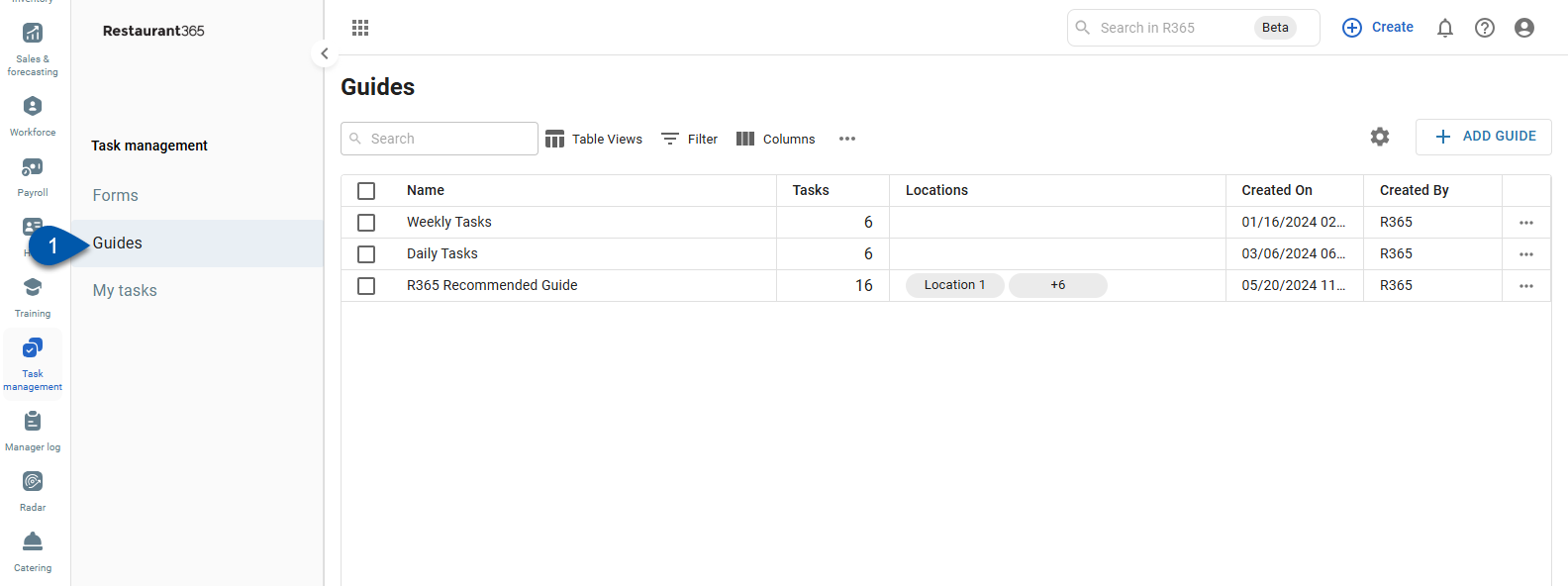
2) Click Open for the desired guide to open the guide details.

3) Click the +Add Task button.

4) Name the task.

5) Select the group for the task.
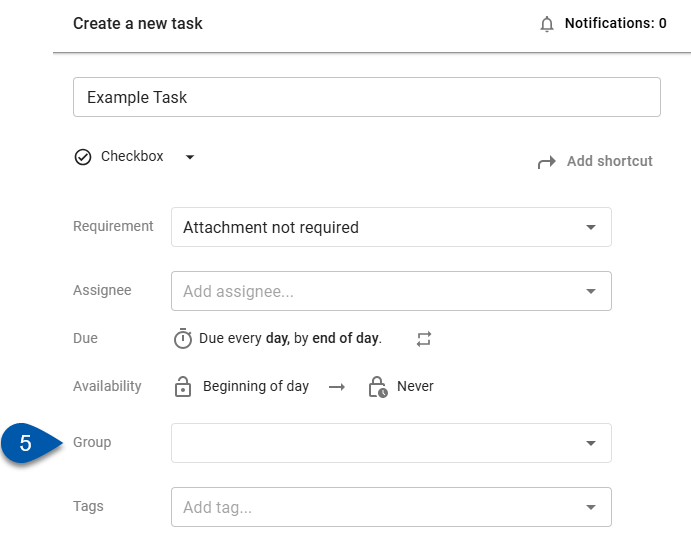
6) Review and edit task details. (Optional)
All details entered will be visible to users when the task is opened to view on the My Tasks page.
By default, the new task will have the following default settings:
Task Type - Checkbox
Select from R365 Actions, R365 Reports, Forms, or standard task types.
Shortcut - None
Requirement - Attachment not required
Assignee - None
Due - Due every day, by the end of the day
Availability - Beginning of day → Never
Tags - None
Description - None
Attachment - None
Notifications - None
7) Click Create Task to create the task and close the task details, or click Create & Add Another to create the task and open a new blank task.
The Create Task and Create & Add Another buttons are disabled when the required Name and Group settings have not been completed.
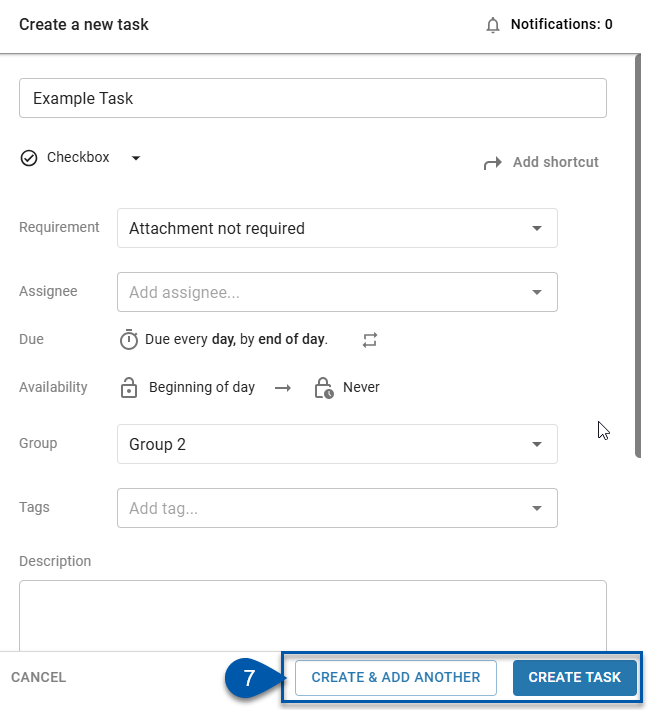
8) Save the guide.

Quick Create Tasks
Tasks can be created quickly through inline editing and keyboard shortcuts. Follow these steps to quick create tasks:
Click steps to expand for additional information and images.
1) Navigate to the Guides page.

2) Click Open for the desired guide to open the guide details.

3) Navigate to the desired task group.
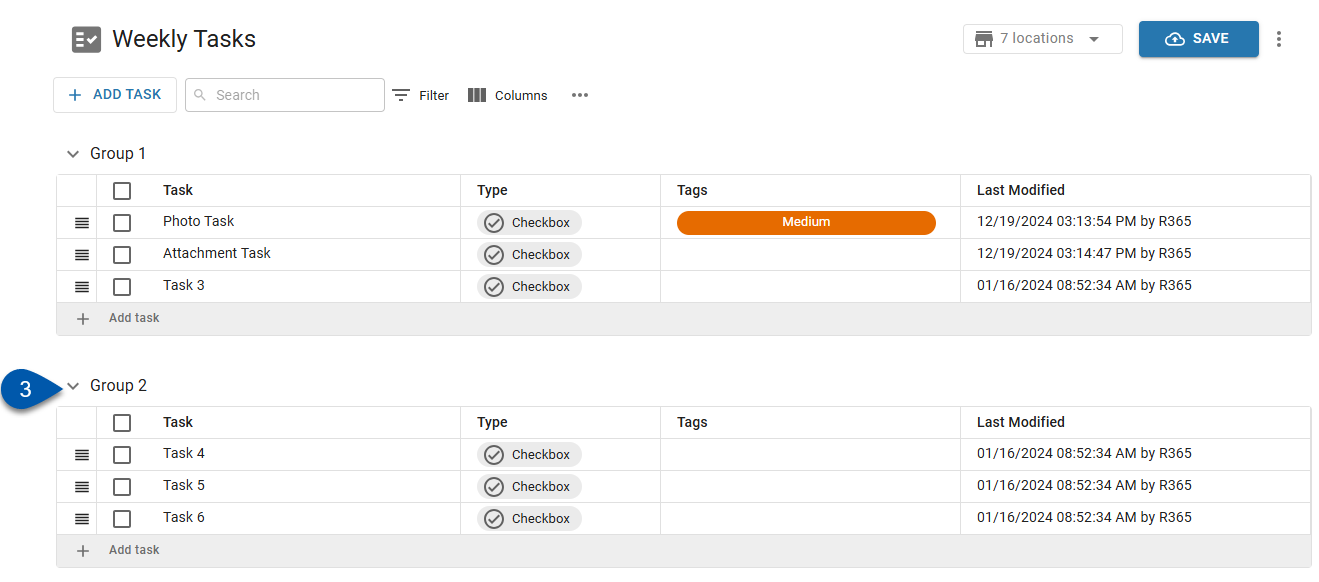
4) Click +Add Task at the bottom of the group.

5) In the inline editing field, enter then Name the task.
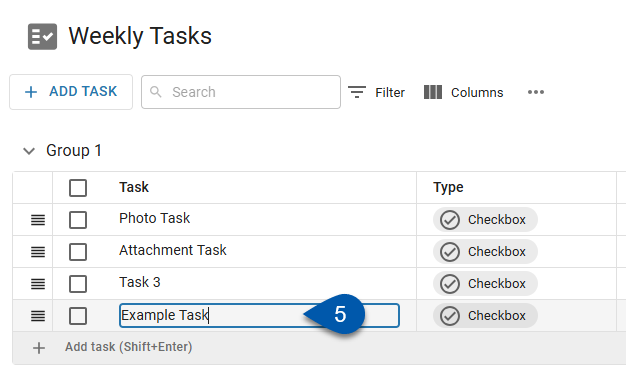
6) Click Enter on the keyboard to create the task or click Shift+Enter on the keyboard to create the task and add another.
The task will be created with the following default settings:
Task Type - Checkbox
Select from R365 Actions, R365 Reports, Forms, or standard task types.
Shortcut - None
Requirement - Attachment not required
Assignee - None
Due - Due every day, by the end of the day
Availability - Beginning of day → Never
Group - Group associated with the +Add Task button
Tags - None
Description - None
Attachment - None
Notifications - None
Record task types have a shortcut automatically included as part of the record requirement setup.
7) Double-click a task to edit its task details. (Optional)
All details entered will be visible to users when the task is opened to view on the My Tasks page.
8) Save the guide.

Edit a Task
Follow these steps to edit an existing task:
Click steps to expand for additional information and images.
1) Navigate to the Guides page.

2) Click Open for the desired guide to open the guide details.

3) Double-click the desired task to open the task details.

4) Edit desired fields.
All the details entered will be visible to users when the task is opened to view on the My Tasks page.
Required Fields:
Task Name
Task Type
Select from R365 Actions, R365 Reports, Forms, or standard task types.
Attachment requirement
Timeline
Availability
Optional Fields:
Tags
Shortcut
Description
Record task types have a shortcut automatically included as part of the record requirement setup.
5) Click the X button in the top right to close the task details.
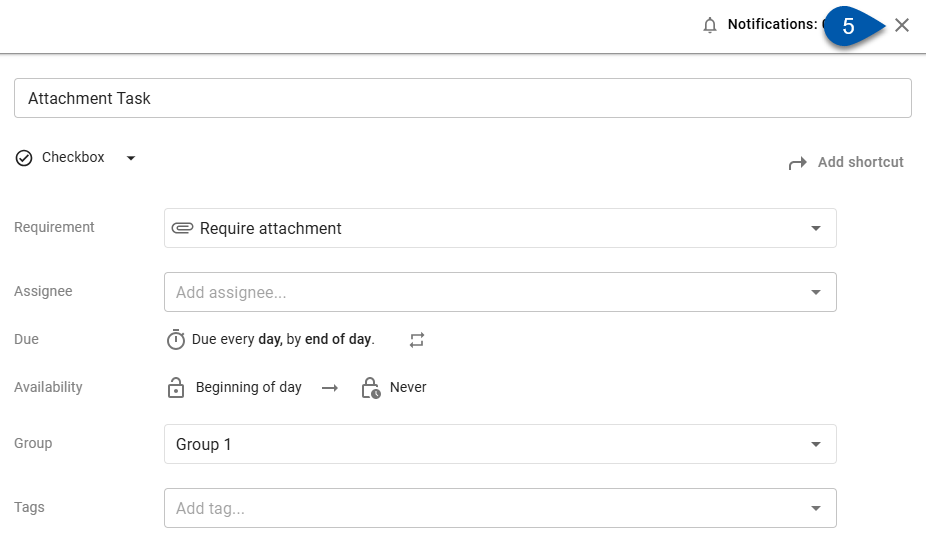
6) Save the guide.

Add or Edit a Task Shortcut
When a shortcut is added, a link to an R365 page or external URL will be available for the user who completes the task.
Record task types have a shortcut automatically included as part of the record requirement setup.
With the task details open, follow these steps to add a shortcut to the task:
1) Click Add shortcut to add a new shortcut, or Edit shortcut to edit an existing shortcut.
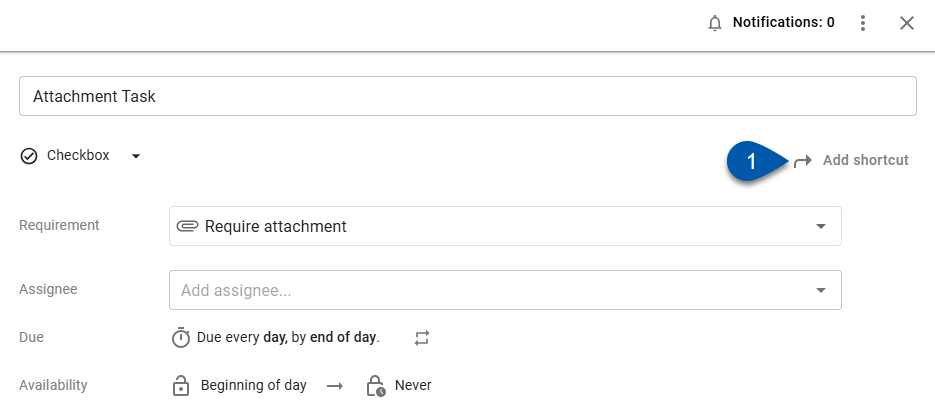
2) Select the desired action; open page or open weblink.
Open Page - When the shortcut is clicked, an R365 page will open.
Open Weblink - When the shortcut is clicked, the configured URL will open.
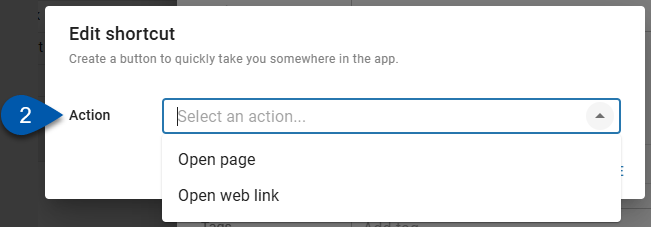
3) If Open page was selected in step 2, select the desired R365 page.
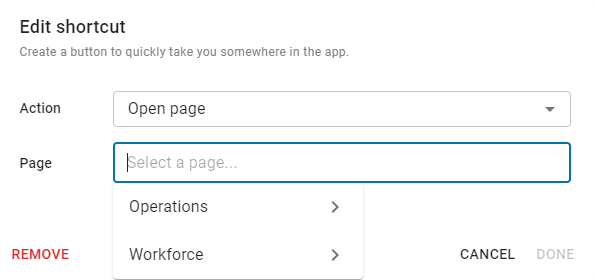
4) If Open weblink was selected in step 2, enter the URL.
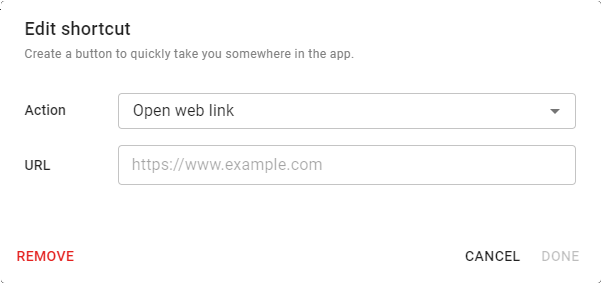
5) Click Done to link the shortcut to the task.
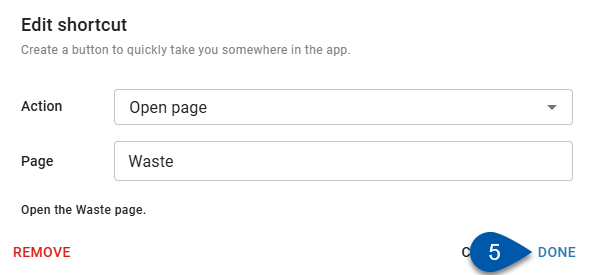
6) If all edits to the task are completed, close the task, then save the guide.
Changes to tasks are not saved until the associated guide is saved.

Set a Task’s Due Timeline (Frequency)
The ‘Due’ configuration for the task determines how frequently the task repeats.
With the task details open, follow these steps to set the task’s frequency:
Click steps to expand for additional information and images.
1) Click the ‘Due’ line to open the Timeline window.
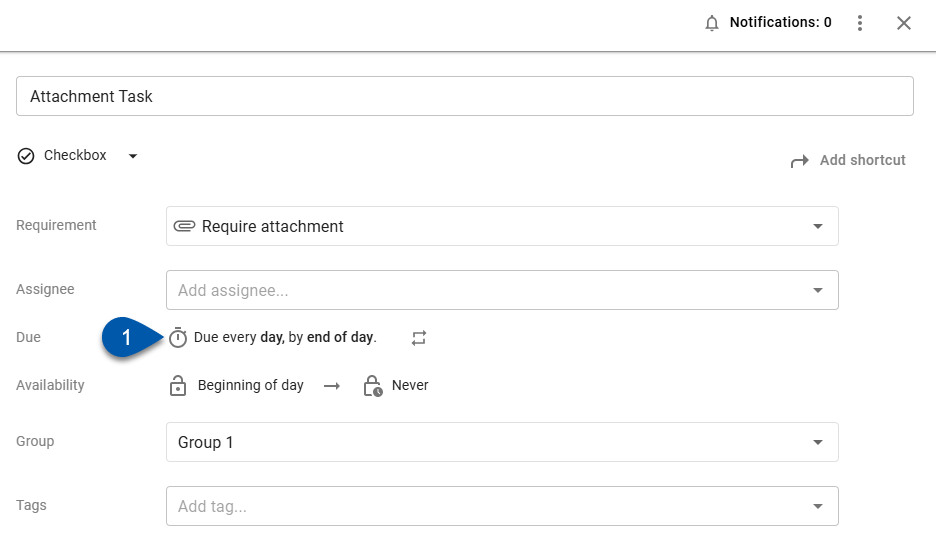
2) In the ‘Repeat by’ field, set how often the task should repeat; days, weeks, months, periods, quarters, or years.
Days - Task will repeat every x days.
Weeks - Task will repeat every x weeks.
Months - Task will repeat every x calendar months.
Periods - Task will repeat every x operational periods or fiscal periods.
Quarters - Task will repeat every x operational periods or fiscal quarters.
Years - Task will repeat every x calendar years, operational years, or fiscal years.
The fiscal calendar defines the periods, quarters, and years for both the fiscal year and operational year.
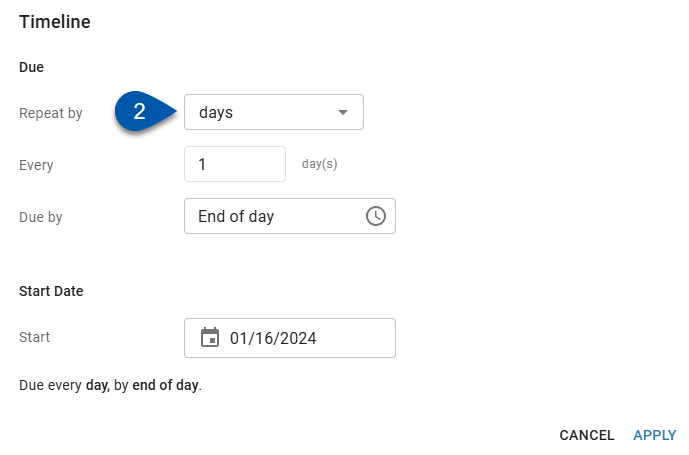
3) In the ‘Every’ field, set the number of days, weeks, months, periods, quarters, or years between occurrences of the task.
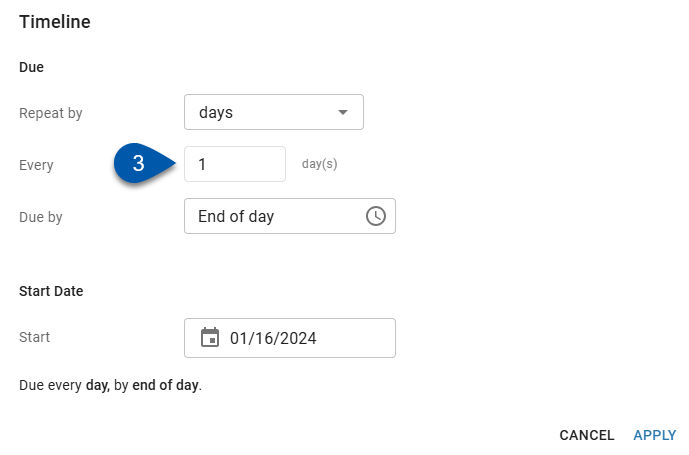
4) In the 'On' field, specify when the task should repeat within the selected 'Repeat By' timeframe.
The ‘On’ field is not displayed when the Repeat By timeframe is ‘Days’.
Week - Select days of the week that the task will repeat.
Month - Select one of the following:
Date of the month (1-31)
Week of the month (first, second, third, fourth, or last) and the day of the week.
Period - Select one of the following:
First day of the period
Last day of the period
First weekday of the period
Last weekday of the period
Custom
Quarters
First day of the quarter
Last day of the quarter
First weekday of the quarter
Last weekday of the quarter
Custom
Years
First day of the year
Last day of the year
First weekday of the year
Last weekday of the year
Specific day of the year
Custom
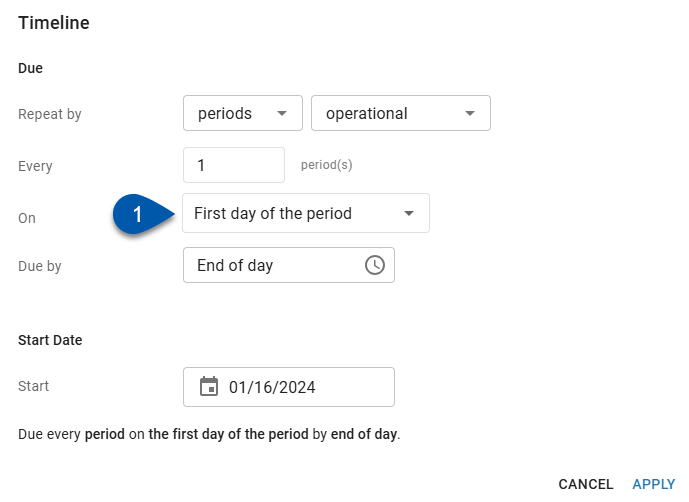
5) If a custom ‘On’ setting was selected for period, quarter, or year, define the custom frequency definition.
The custom frequency definition will be a set number of days or weeks before or after the first or last day of the selected frequency.

Number
Day of the week, day, weekday, or weekend day
Before or After
First day of the frequency or Last day of the frequency
6) In the Due By field, set the time of day that the task is due.
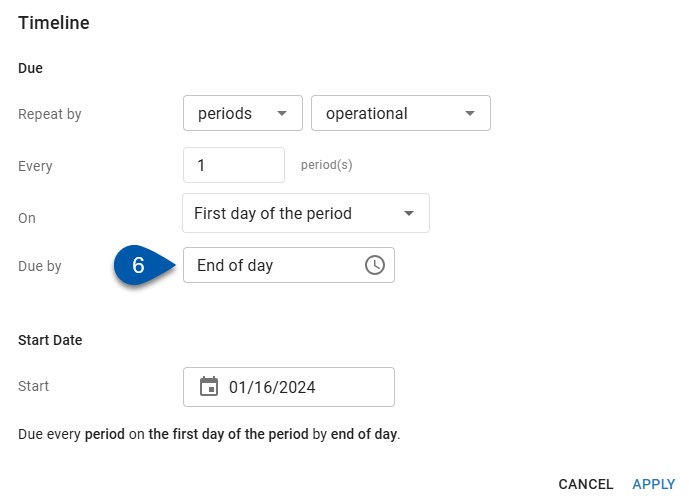
7) Set the start date that the task will begin appearing on My Tasks.
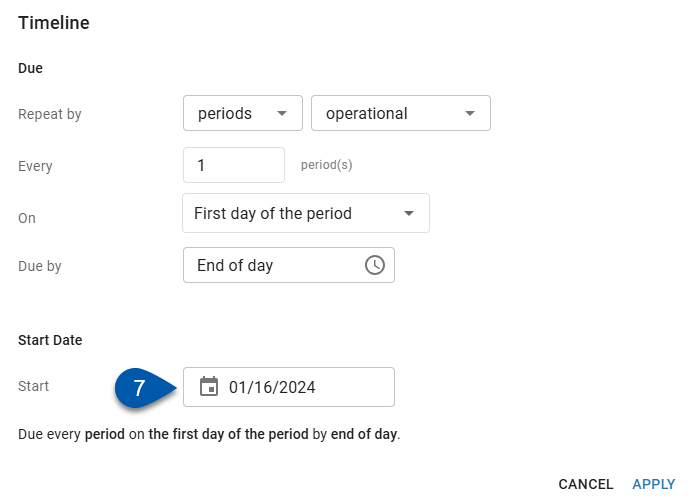
8) Click Apply. The Timeline window will close.
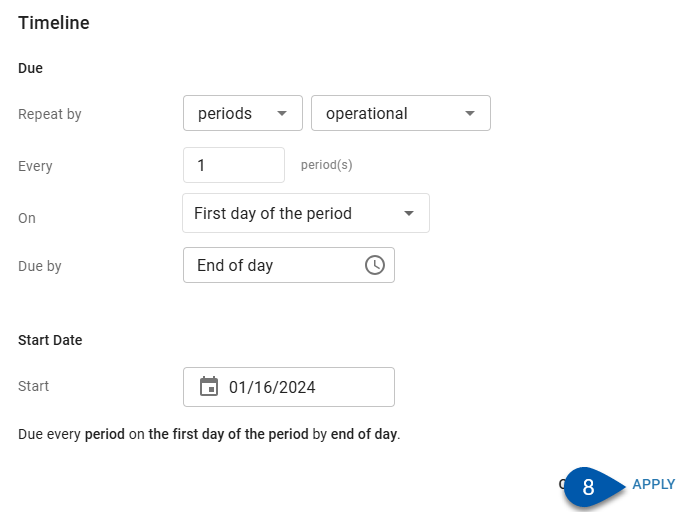
9) If all edits to the task are completed, close the task, then save the guide.
Changes to tasks are not saved until the associated guide is saved.

Change a Task’s Availability
When a task is unavailable, it appears greyed out on the My Tasks page and cannot be opened or accessed in any way. Tasks that are available but not due on the selected day will show up in the Upcoming section of the My Tasks page.
Availability settings do not apply to users with Task Management admin Permissions. Task Management admins can mark a task as complete at any time.
With the task details open, follow these steps to set the task’s availability:
Click steps to expand for additional information and images.
1) Click the ‘Availability’ line to open the Availability window.
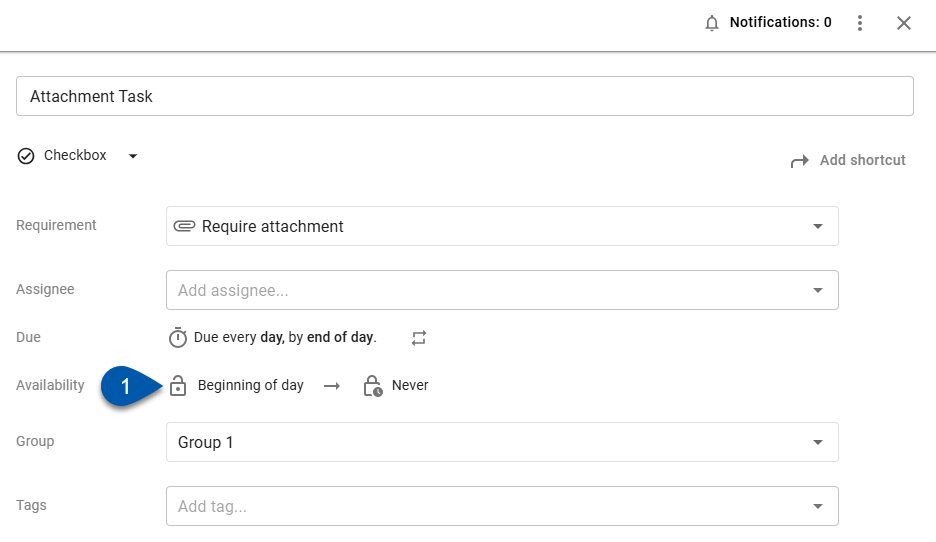
2) Set when the task is unlocked so that users can complete it.
Unlocked options include:
Beginning of day - Task will be unlocked at the first hour of the day of the task.
Custom - Task will be unlocked at either a specific time on the due date or a set number of days before the due date.
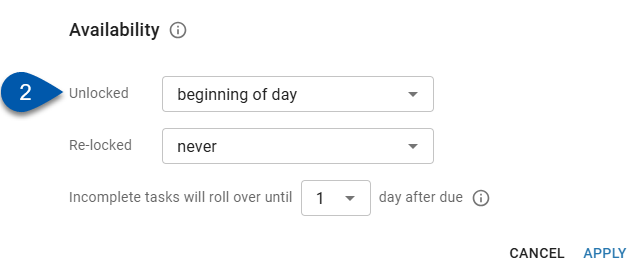
3) Set when the task is re-locked and can no longer be completed by users.
Re-locked options include:
Never - Task will never be locked.
When Due - Task will be locked when it is due.
End of Day - Task will be locked at the end of the day that the task is due.
Custom - Task will be locked at a set time on the due date or a set number of days after the due date.
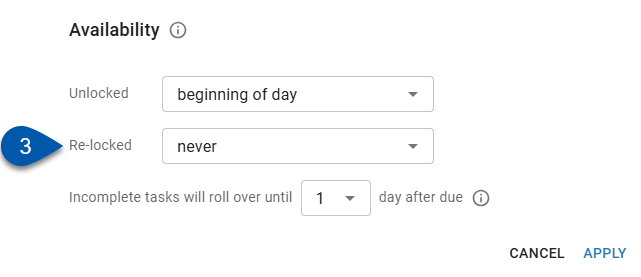
4) If Re-locked is set to Never, set the number of days that the uncompleted task should be rolled over and remain on the My Tasks page after the due date.
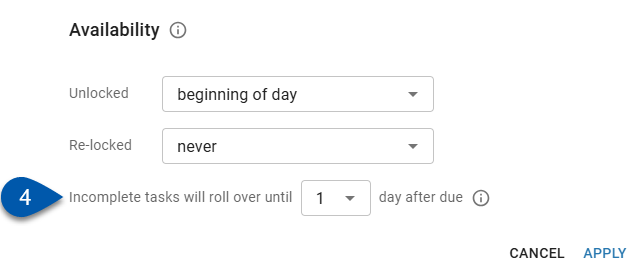
5) If Re-locked is set to Custom and uncompleted tasks should roll over to following days after the due date, toggle the rollover setting on.
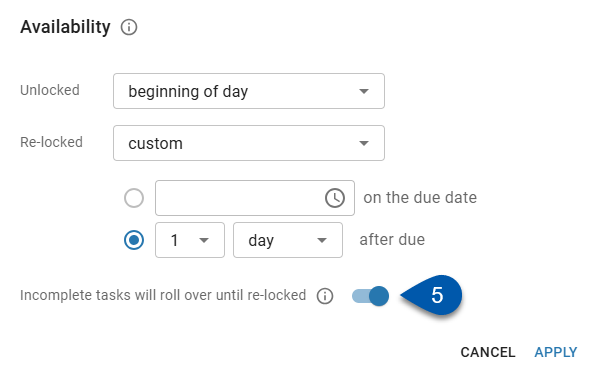
8) Click Apply. The Availability window will close.
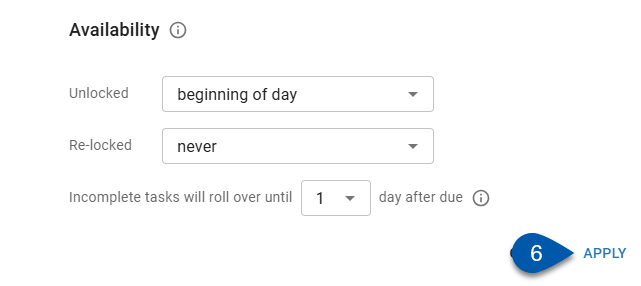
9) If all edits to the task are completed, close the task, then save the guide.
Changes to tasks are not saved until the associated guide is saved.

Add Assignees to a Task
Assignees are the users responsible for completing the task. When the guide is saved, added assignees are notified of the task assignment.
Individual users or user roles can be assigned to tasks.
With the task details open, follow these steps to set the task’s availability:
Click steps to expand for additional information and images.
1) Click the Assignee dropdown menu.
When opened, the Assignee dropdown will show ‘Myself’ listed first. ‘Myself’ is the user that is currently creating the task and editing this field. 
2) Assign the desired user(s) and/or user roles.
Individual users are displayed at the top of the assignee list, followed by user roles. 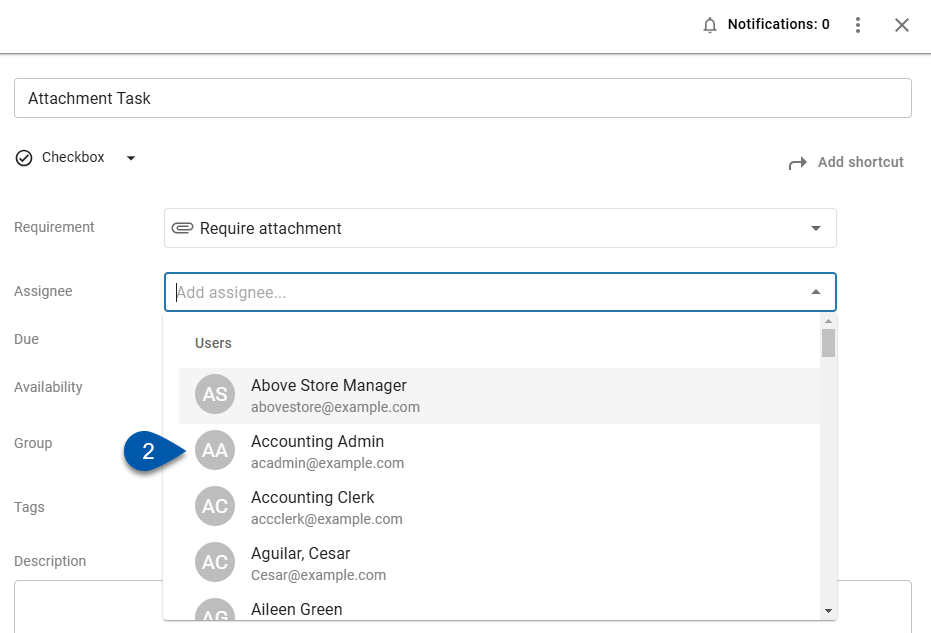
3) If all edits to the task are completed, close the task, then save the guide.
Changes to tasks are not saved until the associated guide is saved.

Remove an Assignee from a Task
With the task details open, follow these steps to set the task’s availability:
Click steps to expand for additional information and images.
1) Click the X icon associated with the desired assignee.

2) If all edits to the task are completed, close the task, then save the guide.
Changes to tasks are not saved until the associated guide is saved.
